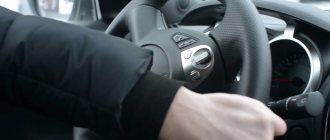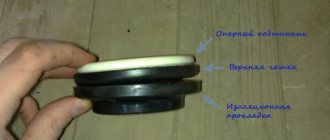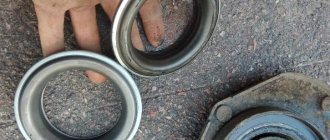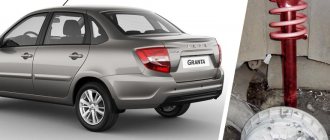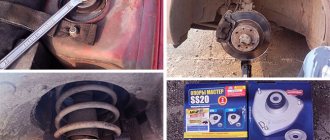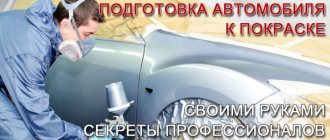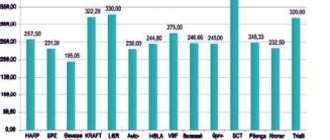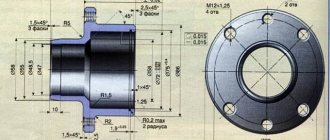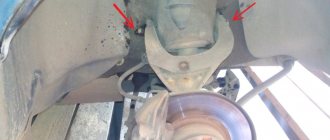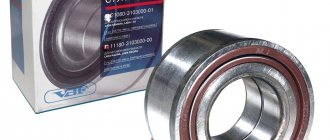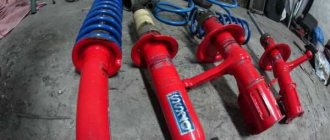- ➡️ Check while driving
- ➡️ Springs
- ➡️ Manufacturers of OP
An important element of a car suspension is the struts and support bearing (OP). It is installed in the front or rear pillar, or rather in the upper support. The bearing ensures mobility and at the same time rigidity of the connection between the shock absorber and the car body.
Front support
The strut effectively dampens vibrations that occur when the car moves on uneven roads. This allows you to reduce the load on the steering, chassis, suspension, and transmission.
The connection between the shock absorber and the car body must remain movable when the wheel is turned. To do this, it is necessary to install an intermediate rolling element between the shock absorber and the body shell, which is subjected to high loads and fails after a certain period of time.
Rear support
The name “support” indicates the main functional purpose of the part. It is this one, located inside the support, that rests on the car body.
The unit ensures smooth running and appropriate controllability of the machine. In addition, the rear wheels receive greater stability on the road. The design and arrangement of the support bearing allows it to withstand fairly high axial and radial loads.
It is important to know:
There is no OP as a rolling element on the rear shock absorber support, since there is no need to rotate the strut.
The main signs of a faulty support bearing
Rear support
- Creaks, knocks, breakdowns in the suspension, the pillar area.
- Increased play between the body body, part, and seat.
- When overcoming rounded irregularities (for example, a speed bump), there is no squeaking, it only appears in the pits.
- Wear of rubber bands between the lower cup and spring.
Knocks in the rear suspension - replacing the support
Front support
- Broken support. This is when the rod pierces the rubber (see photo).
- Wear of the rubber base of the support.
- The appearance of knocking noises when turning the steering wheel;
- A sharp, peculiar crunch that occurs when a wheel overcomes an obstacle.
- Metallic knock.
- Deterioration in vehicle controllability.
- Loss of maneuverability.
- Violation of driving performance, knocking, crunching of the front part of the vehicle body.
- Changing the direction of movement of the front wheels while maintaining a constant steering wheel position.
- Rocking of the body in the direction of travel.
- The distance from the support to the cup is higher than permissible (see photo).
How do support bearings knock?
Clicking noises when turning the steering wheel
What are the functions of shock absorbers and upper mounts?
All tasks assigned to the main parts of a car’s suspension can be divided into two categories: those responsible for the safety of the driver and passengers and those providing comfort while driving.
So, when talking about safety, we first of all mean reliable contact of the wheels with the road: minimizing vertical swaying, “jumping” on holes and potholes, and dangerous deviations of the trajectory when turning. Thus, shock absorbers and upper supports create reliable grip on the road surface and allow the wheel to go around the obstacle as efficiently as possible, and then quickly and quietly return to its original position.
At the same time, they help to increase comfort while driving: it is thanks to their “softening” effect that we do not feel all the unevenness of the road, and are also spared the constant shaking and annoying rattling of car parts.
Causes of support bearing failure
Taking into account the specifics of Russian roads, as well as difficult climatic conditions, it can be determined that the load on the suspension elements is high. For any “opornik” the service life is on average 100,000 km. But when driving on bad roads, this figure decreases by 1.5-2 times.
Rear support
Malfunction of the rear support bearing and its failure is possible in the following cases:
- Wear by mileage;
- Moisture getting inside;
- Late suspension maintenance;
- Driving on bad roads, exposure to dust, dirt;
- Strong shocks (breakdowns) of the suspension when hitting a deep hole;
- Exceeding the maximum permissible weight of cargo placed in the trunk and rear seat.
Front support
Aggressive driving style, poor road conditions or a defective part most often causes a breakdown. Failure occurs earlier for the following reasons:
- Driving on dusty roads.
- Low quality spare parts.
- Natural wear and tear.
- Sharp turns of the steering wheel, drift;
- Sudden braking immediately before an obstacle.
- Wear of the rubber elastic seal.
- Loosening the mounting bolts.
- Malfunction of strut elements (spring, shock absorber, buffer, etc.).
Video on the topic
07.11.2015 111
A support bearing (in common parlance “opornik”) is a subspecies that belongs to rolling bearings. This type of bearing is widely used on modern cars due to its ease of installation, ability to withstand high loads, and excellent performance characteristics.
The “support” is located under the hood, at the top point of the “glass” of the body, in which the shock-absorbing strut is installed. The support bearing is designed to connect the body and shock absorbers; thanks to the “support”, the weight of the car is transferred to the wheels, which rotate. This element of the chassis is very important; without it, handling and a comfortable ride would be out of the question.
What distinguishes a journal bearing from a regular bearing is its thick outer ring (cage). This design feature is explained by the need to withstand severe loads and impacts that come from the wheels.
How to check the knock of the prop on VAZ cars
Before replacing a part, make sure that it has actually failed. On VAZ cars, the condition of the racks and supports should be checked 1-2 times a year. This is what auto mechanics advise in service centers. You can use a fairly simple method, but it will require 2 people. The degree of wear of the support bearing can be determined quite accurately by following these steps.
To clearly demonstrate the verification process, watch the video:
Checking the “supporters” on VAZs
Creaking noise when turning the steering wheel
Checking and operation for a specific car model
You can find specific inspection and operating instructions for a specific car model on our website. Further in the navigation table, you can find and go to instructions for diagnosing and replacing support bearings for your car.
Navigation by instructions:
- Chevrolet:
- Lanos
- Lacetti
- Cruze
- Aveo
- Focus 2
- Accent
- Lancer 9
- Logan
- A80 B4/B3
- Astra H
- Almera
- Nexia
- Octavia
- Corolla
- Ceed
At what interval should a support bearing be diagnosed?
Various manufacturers set their own limits on the service life of this part, which experiences fairly high loads during vehicle operation. The average limit is limited to a mileage of 100,000 km. Taking into account the condition of the roadway, this could be 50,000 km or less. Typically, replacement of a part is required once every 2-3 years.
But in practice, it is necessary to change as a squeak appears, when the maximum degree of wear is reached. Well, the check should be carried out annually, after 20,000 km - mandatory. Moreover, it is not difficult to do this.
Which shock absorbers and supports should I choose?
Read more about how to select shock absorbers and related elements here. In this case, the main criteria that should be relied on are the operating conditions and design features of the machine.
Choose proven and high-quality brands - your safety directly depends on the proper operation of the suspension system.
We recommend the clear leaders in the field of shock absorbers and other suspension elements - companies KYB (KAYABA) and BORT.
KYB shock absorbers and upper supports are impeccable quality, top production technologies, innovative developments and strict control at every stage of production. Reliability and excellent performance are confirmed by numerous tests, tests and certificates. That is why most auto giants equip their cars with KYB shock absorbers on production lines.
BORT shock absorbers and upper mounts come in over 3,000 types and specifications and are sold in more than 80 countries. Automatic regulation and adjustment to driving conditions, resistance to temperature changes, an ideal combination of comfort and safety, as well as compatibility with the model range of all leading manufacturers provide BORT with recognition from both automakers and ordinary motorists around the globe.
* Please check the applicability of parts specifically for your car with our managers by phone (calls within Russia are free).
| Manufacturer | vendor code | Name | Applicability* |
| KAYABA | 333419 | Rear right shock absorber | DAEWOO CHEVROLET LACETTI - RR |
| KAYABA | 333420 | Rear left shock absorber | DAEWOO CHEVROLET LACETTI - RL |
| KAYABA | 443123 | Rear shock absorber | FIAT 124, 125, 126, 127, 128 — R LADA NIVA — R LADA VAZ, NOVA, TOSCANA — R SEAT 1 |
| KAYABA | 339030 | Front left shock absorber | DAEWOO CHEVROLET LACETTI - FL |
| KAYABA | 339029 | Front right shock absorber | DAEWOO CHEVROLET LACETTI - FR |
| KAYABA | 343459 | Rear shock absorber | 10.05/06 - FIAT GRANDE PUNTO - R |
| KAYABA | 341824 | Rear shock absorber | LADA 110 / 112 - R LADA SAMARA, RIVA, DIVA, FORMA, SAGONA - R |
| KAYABA | 333417 | Front right shock absorber | DAEWOO KALOS - F(R) |
| KAYABA | 334840 | Shock absorber | FORD FOCUS C — MAX — F(R) FORD FOCUS II TOURINER — F(R) FORD FOCUS II — F(R) |
| KAYABA | 334839 | Shock absorber | FORD FOCUS C — MAX — F(L) FORD FOCUS II TOURINER — F(L) FORD FOCUS II — F(L) |
| KAYABA | 343098 | Rear shock absorber | FIAT 124, 125, 126, 127, 128 — R LADA NIVA — R LADA VAZ, NOVA, TOSCANA — R SEAT 1 |
| BORT | G22250119 | Shock absorber (replacement of old number B334420) | MITSUBISHI LANCER 00-08 F GAS |
| BORT | G22045110 | Shock absorber (replacement of old number B333741) | RENAULT LOGAN -5 F |
| BORT | G41238056 | Shock absorber | logan, sandero/ rear (Replacement B343418) |
| BORT | 11238131H | Rear shock absorber strut oil | CHEVROLET LANOS/SENS 97- CHEVROLET NEXIA 95-97 OPEL ASTRA 9 |
| BORT | G41245033 | Shock absorber (replacement of old number B341281) | HYUNDAI SONATA IV 98-01, XG |
| BORT | G22050001 | Shock absorber (replacing old number B333712) | VW GOLF II, JETTA II, |
| BORT | 32245001 | Front shock absorber strut oil | DAEWOO NEXIA, LANOS 97-,ESPERO 91-99, OPEL ASTRA F 91-98, VEC |
| BORT | G22250094R | Shock absorber (replacing old number B333419R) | CHEVROLET LACETTI -4 R GAS |
| BORT | G11238064 | Shock absorber (replacing old number B343304) | DAEWOO MATIZ |
| BORT | G21848001R | Shock absorber (replacement of old number B332108R) | HUNDAI ACCENT 00-05 |
In IXORA stores you can always buy shock absorbers and upper supports of all the most popular types and brands. And our qualified specialists will help you with your choice!
Malfunction of other rack elements
All of the above methods for checking the rolling element are quite accurate and effective. But none of them gives a 100% guarantee until the unit is disassembled. The cause of the creaking that appears in the area may be steering rods or other adjacent parts or suspension elements.
Spring fault
If the strut spring sags or breaks, this will immediately result in a deterioration in comfort and a decrease in the vehicle’s handling quality. And hence the decline in road safety in general. A sagging spring on one of the wheels is clearly visible visually. Creaking and grinding noises are only possible if it breaks.
How to identify a malfunction of the support itself (not the bearing)
If the support is worn out, a dull sound or knocking sound will be heard when overcoming uneven sections of the road. It is easy to verify that the support is faulty; you just need to assess the condition of the rubber bands. If they are damaged or do not take their place, the entire support will have to be replaced.
Compression progress buffer failure
A rubber or polyurethane compression stroke buffer may lose its integrity or elasticity over time. In this case, extraneous creaks and noises may appear that occur at the moment of maximum compression of the spring. A standard visual inspection of the element will help verify the malfunction (or absence thereof).
Shock absorber wear
There are several ways to determine the wear of a part. This includes noise on bumps and excessive body roll, especially during sharp turns. The malfunction of the shock absorber is most clearly felt when overcoming an uneven section at speed, when the car continues to sway for some time.
Why is shock absorber wear dangerous?
First of all, faulty shock absorbers are always a risk of losing control of the car. Skidding, rolls, unexpected bouncing, increased braking distance, general decrease in control of the road situation - this is not a complete list of troubles that can arise when these suspension elements malfunction.
In addition, a rationalistic aspect is added to the safety issue: improper functioning of shock absorbers and upper supports inevitably leads to wear of other parts - most often, brakes and tires.
Finally, we must not forget about the general condition of the car and the driver: due to the less obedient and predictable response of the car, the driver is forced to constantly be on alert, and therefore experience double fatigue and stress. What a pleasure it is to drive!
Recommendations for checking and extending the service life of supports
If replacement is required
To easily and quickly dismantle a worn out faulty unit, you need to prepare a special rack wrench. It is assembled from 2 tubes of different diameters, obtaining a lever of the appropriate length.
Periodic inspection
Regular inspection and timely maintenance are a guarantee of increasing the service life of spare parts. Check the unit after 10-12 thousand kilometers, especially since this is not difficult to do.
Timely lubrication
Regardless of the car’s mileage, at least once a year (preferably twice, in spring and autumn), it is necessary to lubricate the support with silicone grease. Carry out the work with the protective cover removed.
Accurate vehicle control
Driving your car carefully, without sudden acceleration or jerking, as well as driving on good roads, is the best way to protect parts from premature wear.
Modernization and strengthening
To strengthen the supports, spacers are used to increase ground clearance and auto-buffers, which absorb the load. They also make a spacer between the posts.
The best manufacturers
OPs are produced by different companies. The optimal solution is to install original parts. Purchasing spare parts made in China is risky and there is a high risk of defects. Users of numerous forums note the best bearing manufacturers:
| Item No. | Brand name | Official company logo | A country |
| 1 | SNR | France | |
| 2 | SKF | Sweden | |
| 3 | F.A.G. | Germany | |
| 4 | INA | Germany | |
| 5 | Koyo | Japan |
Signs of wear on shock absorbers and upper mounts: identify and eliminate!
| published 03/11/2016 |
Any motorist will confirm: our roads are impossible without good shock absorbers! And it’s not even about the quality of the first ones - or rather, not only about it. Alas, Russian climatic conditions with nine months of winter are by no means conducive to a comfortable and trouble-free ride: sometimes ocean-deep puddles, sometimes shoulder-deep snowdrifts, sometimes a mess of salt, sand and reagents, sometimes bare ice. So shock absorbers and upper supports have to take the lion's share of responsibility - which means premature wear is inevitable. Read this article on how to promptly diagnose faulty shock-absorbing elements and avoid expenses associated with subsequent repairs.
Why you shouldn’t delay repairs
When the OP has completely disintegrated, you can continue moving. But driving with a damaged bearing will significantly accelerate the wear of other suspension parts. Also, usually with such a break the geometry is disrupted: descent and camber. This not only causes accelerated tire wear, but can also significantly reduce the vehicle's handling. This increases the risk of accidents. Therefore, prolonged driving with damaged support bearings is not recommended.
Every car owner needs to know this.
The mounts themselves require no maintenance and are durable. But you need to change worn-out media on time. A serviceable car is the key to safety on the road!
Replacement
Replacing the front support bearings is quite simple. The main thing is to find a really high-quality part, because not all manufacturers can provide supports with a high degree of wear resistance. So, we arm ourselves with the following tools:
- spanner;
- head for disassembling racks;
- spark plug head for ratchet;
- rod nut wrench;
- spring compressors.
And, of course, the prop himself. We will carry out the replacement procedure as follows:
- Jack up and remove the wheel.
- Remove the two nuts securing the front strut to the hub.
- Unscrew the nut from the shock absorber rod, while holding it with a hexagon.
- We remove the stand.
- Compress the spring and remove the support bearing.
- We again clamp the hexagon on the rod and unscrew the nut.
- We remove the bearing, install a new one and repeat all the steps, only in reverse order.
The cause of knocking while turning may be a malfunction of the steering rack, steering shaft or steering cardan. Therefore, after replacing the support, the problem may not disappear. In this case, all of the above systems should be checked.
Video on replacing the support:
Roads are called one of the two main “troubles” of Russia. Constant holes and potholes cause not only inconvenience in terms of comfortable movement, but also cause significant damage to the car’s suspension, its individual elements, especially bearings. Replacing them is not difficult, even a beginner can handle it, but diagnosing the need for this replacement in a timely manner is much more difficult, especially without knowing the signs of a faulty support bearing. We will talk about them further, but first a little theory.
